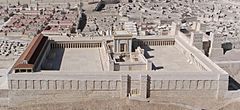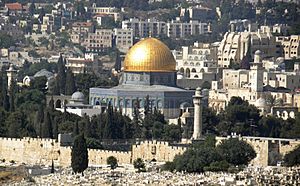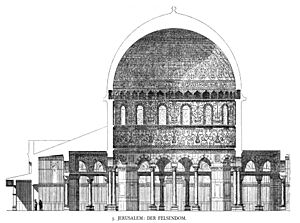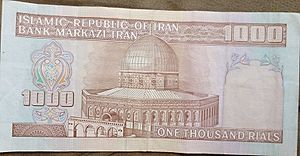Dome of the Rock facts for kids
The Dome of the Rock (which means "Mosque of the Dome of the Rock" in Arabic) is a very important Islamic shrine in Jerusalem. It stands on the Temple Mount in the city's Old City.
It was built between 691 and 692 by Caliph Abd al-Malik. It is believed to be built where the ancient Jewish Temple once stood. Muslims also believe this is the place where Muhammad, their prophet, went up to heaven.
Contents
History of the Dome of the Rock
Before Islam

The Dome of the Rock is in the middle of the Temple Mount. This area was once home to the Temple of Solomon and the Jewish Second Temple. King Herod the Great made the Second Temple much bigger around 1st century BCE.
The Romans destroyed Herod's Temple in 70 CE. After a Jewish revolt in 135 CE, a Roman temple was built there.
Jerusalem was ruled by the Christian Byzantine Empire from the 300s to the 600s. Many Christians started visiting Jerusalem during this time. The Church of the Holy Sepulchre was built in the 320s. But the Temple Mount area was left empty.
How it was Built
Most people believe the Umayyad Caliph Abd al-Malik ordered the building of the Dome of the Rock. His son, Al-Walid I, also helped. Building started in 687. It cost a lot of money, like seven times Egypt's yearly tax income.
An old writing is still inside the dome. It says the building was finished in 691 or 692 CE. The name of al-Malik was later changed to another caliph's name.
The building's design and decorations were like nearby Byzantine churches and palaces. Two engineers, Raja ibn Haywah and Yazid Ibn Salam, led the project.
Some historians think the Dome of the Rock was built to be as grand as other religious buildings. It has a round shape, which was not common in early Islamic buildings. This round shape was similar to many Christian domes. The builders used measurements from the Church of the Holy Sepulchre. The Dome of the Rock is about 20.20 meters (66 ft) wide and 20.48 meters (67 ft) high. The Church of the Holy Sepulchre's dome is very similar in size.
The building has eight sides. It has a wooden dome, about 20 meters (66 ft) wide. This dome sits on a raised drum with 16 pillars and columns. Around this circle is an eight-sided walkway with 24 pillars and columns.
Later Changes and Repairs
The building was badly damaged by earthquakes in 808 and 846. The dome fell in an earthquake in 1015. It was rebuilt in 1022–23. The decorations on the drum were fixed in 1027–28.
The Crusaders' Time
For many years, Christian visitors could go to the Temple Mount. But attacks on visitors led to the Crusades. In 1099, the Crusaders captured Jerusalem. They turned the Dome of the Rock into a church. The Al-Aqsa Mosque became a royal palace.
The Knights Templar, a group of knights, believed the Dome of the Rock was the Temple of Solomon. They made the Al-Aqsa Mosque their main base. The Dome of the Rock, which they called Templum Domini, was even on their official seals. It became a model for round Templar churches in Europe.
Ayyubids and Mamluks
Saladin took Jerusalem back on October 2, 1187. The Dome of the Rock became a Muslim shrine again. The cross on top was replaced with a crescent. A wooden screen was put around the rock inside.
Saladin's nephew, al-Malik al-Mu'azzam Isa, also made repairs to the building.
The Dome of the Rock received much care from the sultans during the Mamluk period (1250 to 1510).
Ottoman Empire (1517–1917)
During the rule of Suleiman the Magnificent (1520–1566), the outside of the Dome of the Rock was covered with beautiful tiles. This work took seven years.
The inside of the dome is richly decorated with mosaic, faience (glazed pottery), and marble. Much of this was added many years after it was first built. It also has writings from the Qur'an.
The Surah Ya Sin (called the "Heart of the Quran") is written across the top of the tile work. This was added in the 1500s by Suleiman the Magnificent. Above this is Al-Isra, which tells the story of the Night Journey.
Near the Dome of the Rock, the Ottomans built the Dome of the Prophet in 1620. Big repairs were done in 1817 during the rule of Mahmud II.
In 1874–75, during Sultan Abdülaziz's rule, many old tiles on the outside walls were replaced. New copies were made in Turkey.
Recent History
Amin al-Husseini, a leader appointed by the British, helped restore the Dome of the Rock and the Al-Aqsa Mosque in Jerusalem. This happened during the British rule of Palestine starting in 1917.
The Dome of the Rock was badly shaken by an earthquake on July 11, 1927. Many of the recent repairs were damaged.
In 1955, the government of Jordan started a big repair project. Money came from Arab governments and Turkey. Many tiles from Suleiman the Magnificent's time were replaced. In 1965, the dome was covered with a strong aluminium bronze metal from Italy. This replaced the old lead covering.
Before 1959, the dome was covered in dark lead. From 1959 to 1962, the lead was replaced with aluminum-bronze plates covered with gold leaf.
After the Six-Day War in 1967, the Israeli flag was put on the Dome of the Rock. But Moshe Dayan ordered it to be taken down a few hours later. The Muslim waqf (a religious group) was given control of the Temple Mount. This was done to "keep the peace."
In 1993, the golden dome was fixed again. King Hussein of Jordan gave 8.2 million US dollars for this. He sold one of his houses in London to pay for the 80 kilograms (176 pounds) of gold needed.
The Dome of the Rock is shown on the back of the Iranian 1000 rials banknote.
Visiting the Dome of the Rock
The Dome is cared for by the Ministry of Awqaf in Amman, Jordan.
Until the mid-1900s, non-Muslims were not allowed in the area. Since 1967, non-Muslims can visit but with some rules. Non-Muslims cannot pray on the Temple Mount. They also cannot bring prayer books or wear religious clothes. The Israeli police help make sure these rules are followed.
Some Orthodox rabbis encourage Jews to visit the site. But most forbid entering the area to avoid breaking Jewish law. Even rabbis who allow visiting the Temple Mount do not allow entering the Dome of the Rock itself.
Religious Importance

Some Islamic scholars believe the rock inside the Dome is where the prophet Muhammad went up to Heaven. He was with the angel Gabriel. Also, Muhammad prayed there with Abraham, Moses, and Jesus. Other Islamic scholars believe he went to Heaven from the Al-Aqsa Mosque.
Muslims believe the Dome of the Rock is the place mentioned in Sura 17 of the Qur'an. This part tells the story of the Isra and Mi'raj, Muhammad's amazing Night Journey. He traveled from Mecca to "the farthest mosque." There, he led prayers and then rose to heaven to get instructions from Allah (God).
The Foundation Stone and the area around it are the holiest site in Judaism. Muslims now pray facing the Kaaba in Mecca. But they once faced the Temple Mount, like Jews do. Muhammad changed the direction of prayer for Muslims after a message from Allah. Jews traditionally see the stone's location as the holiest place on Earth. It was the site of the Holy of Holies during the Temple Period.
Jewish tradition says this stone is where Abraham prepared to sacrifice his son Isaac.
On the walls inside the Dome of the Rock, there are writings from the Quran. These writings explain that Jesus was a true prophet but not the son of God. They say, "It is not fitting for Allah to have a child. Glory be to Him!" This shows that the building's messages were partly aimed at Christians.
Images for kids
-
Reverse of a 1,000 Iranian rial banknote (1992).
-
Reverse of a 1 Jordanian dinar banknote (1959). Since 1992, the 20 Dinar note bears the Dome's depiction.
-
Obverse of a 50 Saudi riyal banknote (1983).
-
Obverse of a 1 Palestinian pound banknote (1939).
-
Panorama of the Temple Mount, including Jami Al-Aqsa and Dome of the Rock, from the Mount of Olives
-
Stereo card of the Dome of Rock (late 19th century)
See also
 In Spanish: Cúpula de la Roca para niños
In Spanish: Cúpula de la Roca para niños























